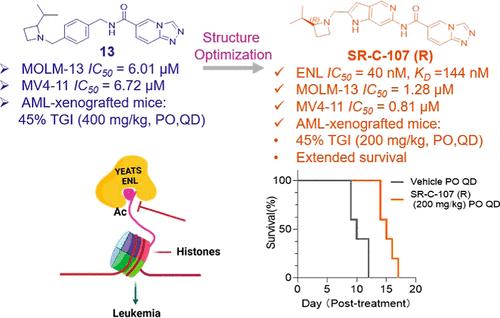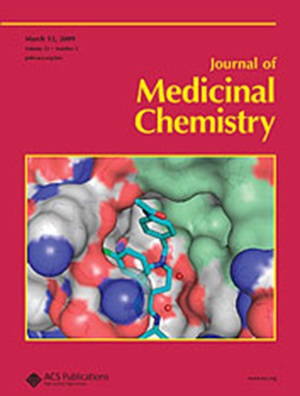Prioritization of Eleven-Nineteen-Leukemia Inhibitors as Orally Available Drug Candidates for Acute Myeloid Leukemia
IF 6.8
1区 医学
Q1 CHEMISTRY, MEDICINAL
引用次数: 0
Abstract
Acute myeloid leukemia (AML) is the second most prevalent and fatal form of leukemia. The growth of AML cells harboring oncogenic MLL rearrangements relies on the YEATS domain-containing protein ENL. Many small molecule inhibitors targeting ENL have been developed. To prioritize these inhibitors for in vivo studies, a NanoBRET system was introduced to evaluate their cellular permeability and potency. This screening identified inhibitor 13 as a promising candidate. This inhibitor has remarkable metabolic stability and potent antiproliferative effects on MLL-fusion leukemia cell lines. In AML-xenografted mice, inhibitor 13 significantly improved survival. Subsequent optimization efforts led to the development of SR-C-107 (R), which exhibited strong activity against AML both at the cellular level (CC50 (MOLM-13): 1.25 ± 0.18 μM; CC50 (MV4-11): 0.81 ± 0.15 μM) and in vivo. These findings establish SR-C-107 (R) as a compelling candidate for AML treatment and lay the groundwork for the development of next-generation AML inhibitors.

将 11-19 种白血病抑制剂列为急性髓性白血病口服候选药物的优先顺序
急性髓性白血病(AML)是发病率第二高的致命性白血病。携带致癌 MLL 重排的 AML 细胞的生长依赖于含 YEATS 结构域的蛋白 ENL。目前已开发出许多针对 ENL 的小分子抑制剂。为了优先选择这些抑制剂进行体内研究,我们引入了一种 NanoBRET 系统来评估它们的细胞渗透性和效力。筛选结果表明,抑制剂 13 是一种很有前途的候选药物。这种抑制剂具有显著的代谢稳定性,对 MLL 融合型白血病细胞株具有强效的抗增殖作用。在急性髓性白血病异种移植小鼠中,抑制剂 13 能显著提高存活率。随后的优化工作促成了 SR-C-107 (R)的开发,它在细胞水平(CC50 (MOLM-13):1.25 ± 0.18 μM;CC50 (MV4-11):0.81 ± 0.15 μM)和在体内对急性髓细胞白血病的活性进行了评估。这些发现使 SR-C-107 (R) 成为治疗急性髓细胞性白血病的令人信服的候选药物,并为开发下一代急性髓细胞性白血病抑制剂奠定了基础。
本文章由计算机程序翻译,如有差异,请以英文原文为准。
求助全文
约1分钟内获得全文
求助全文
来源期刊

Journal of Medicinal Chemistry
医学-医药化学
CiteScore
4.00
自引率
11.00%
发文量
804
审稿时长
1.9 months
期刊介绍:
The Journal of Medicinal Chemistry is a prestigious biweekly peer-reviewed publication that focuses on the multifaceted field of medicinal chemistry. Since its inception in 1959 as the Journal of Medicinal and Pharmaceutical Chemistry, it has evolved to become a cornerstone in the dissemination of research findings related to the design, synthesis, and development of therapeutic agents.
The Journal of Medicinal Chemistry is recognized for its significant impact in the scientific community, as evidenced by its 2022 impact factor of 7.3. This metric reflects the journal's influence and the importance of its content in shaping the future of drug discovery and development. The journal serves as a vital resource for chemists, pharmacologists, and other researchers interested in the molecular mechanisms of drug action and the optimization of therapeutic compounds.
 求助内容:
求助内容: 应助结果提醒方式:
应助结果提醒方式:


